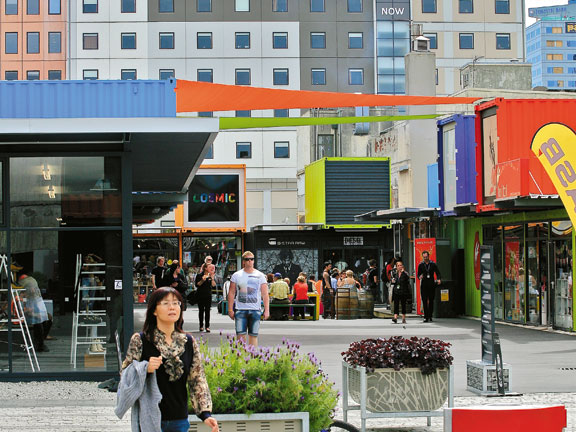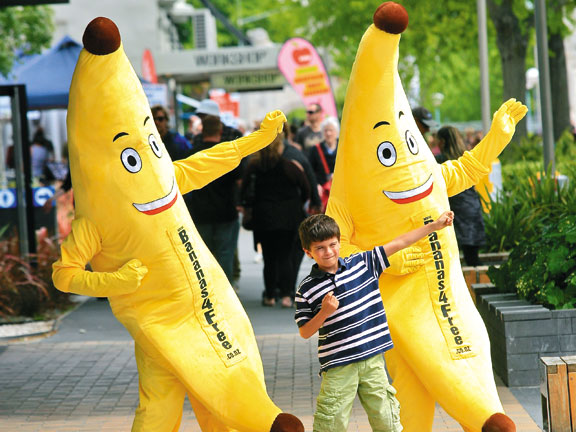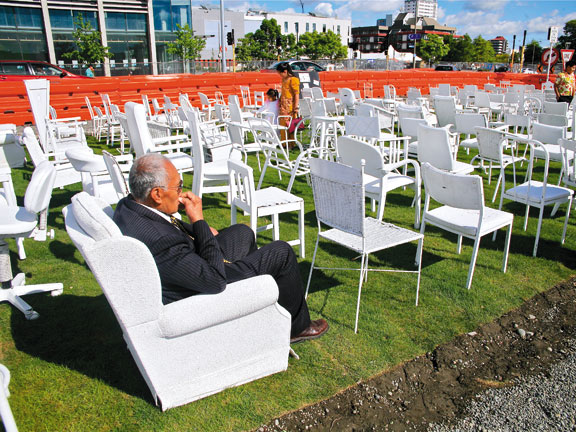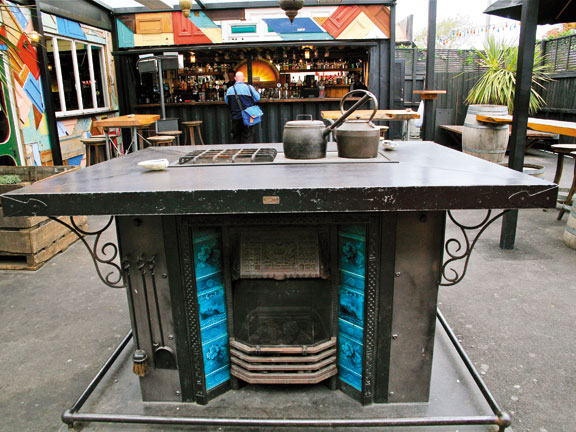On the ruined rugby pitch of Christchurch's AMI Stadium a wild daisy sprouts heroically from a crack in the centre of a lake of liquifaction. Blooming, despite the odds, its two white flowers are symbolic of many of the things that are happening in that belaboured city.
Understandably the mind-set in Christchurch over the last two years has been deeply rooted in the catastrophe. But in the last few months the cultivation of hope and enthusiasm has given rise to enjoyment of the present, trust in a future, and some wildly creative ideas.
But first it's worth coming with me on a tour bus through the Red Zone of the CBD — or what's left of it. Like all New Zealanders, I'd seen plenty of photographs of the disaster and yet I was shocked by the reality — the extent of broken buildings and the yawning spaces left where they have been demolished.
But even if it was downward, the place was on the move, accompanied by a crazy sort of orchestra — the percussion of jack hammers, the roar of bulldozers, and the nerve-jerking crash of falling masonry.
The past tense was used a lot as we journeyed through all this in the bus: “Here was the Christchurch Convention Centre; Cramner Courts were there; the Crowne Plaza over there; that was the train station; along here Oxford Terrace...” — all gone.
I knew Christchurch well and yet I now found it hard to get any bearings. There were exceptions: the Botanic Gardens was as carefully tended to as ever and bursting with good cheer in its spring livery; I punted down the Avon River which winds through the Red Zone — a very different landscape but still there; and I when wandered through Hagley Park I was tempted to forget that anything had ever happened, the surrounds sending me to times past.
It was a different story in Madras Street where I walked past the site of the CTV building, now just a desolate patch of naked ground. Tucked into the surrounding wire fence, a few fading bouquets signaled that a terrible event had happened here. Across the road, on the site of the demolished Baptist Church, local artist Pete Majendie had sourced, painted, and placed in rows 185 white chairs to create a powerful memorial for the 185 lives lost in the 22 February, 2011 earthquake.
There will always be memorials; nothing can erase the memory of such cataclysmic events. But the present tense is also becoming important in Christchurch. With it comes a new vernacular — words like 're-imagined', 'restart', 'gap-fillers', 'pop-ups' and 'parklets' are signs of new life in the devastated city — simutaneously exciting and heart warming.
You can see it on the walls of damaged buildings which have become artists canvasses. Murals and humorous graffiti brings smiles and mood shifts. Most recent is one in Worcestor Street where a Melbourne-based artist fired paint from fire extinguishers onto a concrete wall to create vibrant cascades of colour. The neo-Gothic Arts Centre, (badly damaged and red-carded but to undergo restoration) is unusable at the moment and so an exhibition has been mounted on weather-resistant placards outside on the pavement.
There are pop-ups and gap-fillers everywhere. These make temporary use of empty sites and are thought up, constructed, and run by volunteers under the auspices of the Gap-filler Trust. Experimentation is high,expenditure low.
On a visit to Christchurch you cannot hope to see them all. The most obvious and the most loved is the Restart Centre in Cashel Street. Built from a hundred colourfully-painted shipping containers sourced from Shanghai, this temporary hub houses 41 retail outlets, cafes and restaurants. Many of them are businesses Christchurch knew before the quakes.
Spring was in the air the day I was there. The mood was festive. People had dressed in bright colours, the cafes were full, takeaway food was being served from caravans and eaten on seats in the square. Bands played, jugglers juggled, and street performers drew gaggles of onlookers. An outdoor market was in full swing.
Throughout the city, various empty sites are being been used for sports activities. An empty lot in Hereford Street is now a mini soccer field (Nike Football in the Gap). Filling other spaces I found giant chess, a petanque court, and around Colombo Street, Gap Golf where several putting holes on faux grass have been created among the ruins.
One pop-up with a sporty link was particularly intriguing. At the open-air Cycle Cinema the audience parked their bikes in rows on some sort of connecting apparatus and when they began peddling in unison, the movie started to run. Unfortunately, in the manner of true pop-ups, this no longer exists.
But Danc-o-Mat is still there. People take their own music to this innovative open-air dance floor, which hit the news when Prince Charles took a twirl during the recent royal visit. In early December, the Pavilion pop-up opened. Its walls and seating are made from blue timber pallets into which masses of plants have been integrated to form secret gardens. The venue, with its small stage and sound system, comes alive in the evenings with musical (and other) performances.
Many of the pop-ups and gap-fillers taking up residence are more to do with sustenance than with entertainment. On the corner of Bealey Avenue and Caledonian Roads, Rene and Pavi Bell have relocated their restaurant. They'd run a Thai Restaurant in Hereford Street before the building collapsed in the February earthquake.
“We made it out,” says Rene. “That was our first bit of luck.”
The couple then created their own silver lining amidst the disaster: they got hold of a container and an old caravan, painted them with murals of Thai mountain scenes, covered a vacant lot with gravel, set up a row of bench tables, and began trading. Thai Container is now one of 'the places' to eat in Christchurch's CBD. A steady rain was falling the evening I tried it but weather couldn't diminish the taste of the couple's famous spring rolls. Eating them under an umbrella just added to the experience.
I have to admit, I loved the pop-up bars. They are loaded with character. Over the course of two nights, I imbibed in three of them. Revival is set in two containers. Funky and off-beat, its seating is made from old travel trunks and the boot of an old car. Its exterior walls are covered with random bits of coloured timber.
Next I went to Smash Palace. The bar is in an old bus and patrons sit under umbrellas in a courtyard surrounded by a canvas wall. In one corner of the yard a diminutive caravan painted white has been put to use as the office of Magpie Motors Workshop — a hospital for small motorbikes.
“Oh, you must try the Cargo Bar,” a local fellow told me. He was very much my junior. The Cargo Bar is on Lincoln Road. It's also built out of shipping containers and is a happening nightlife spot for the young and going-places set. I seemed to be the only grey-head in the bar; so I swallowed one of their famous cocktails — they are now served in jam jars — and slunk away.
But there's one new restaurant In Christchurch that you would have to pay me to slink away from. CI Espresso is not exactly new, as it was well-known before the quake completely destroyed it. At that time, owner Sam Crofskey, had two hours and a wheelie bin to rescue what he could. Two years later he has creatively resurrected CI Espresso in High Street's solid and almost solitary survivor — the old Post Office building. As well as serving great food and coffee, the restaurant has been reinvented as a voyage of discovery. Water is dispensed through an old Singer sewing machine, for instance; food orders are shot from café to kitchen through a vacuum tube that runs across the ceiling; the sliding door to the kitchen doubles as a bookcase; and a spiral staircase leads to a garden bar on the rooftop, which is planted with grape vines and home to a beehive. The restaurant, with all its innovations, art work, and quirky features is a visual adventure. But the things that impressed me most about CI Espresso were the dedication of its owners to sustainability and the use of recycled material from other earthquake-affected buildings. In that way, it is not just a restaurant but another symbol — of how when one door shuts (or shatters beneath a pile of rubble) another can open to a brighter future; how the brave can lift themselves up from catastrophe, dust themselves off, and start all over again.
For the latest reviews, subscribe to our Motorhomes, Caravans & Destinations magazine here.

The road to Milford Sound
Explore the awe-inspiring journey to Milford Sound through Fiordland National Park – from scenic DOC campsites and iconic hikes to wildlife cruises and luxury stays









